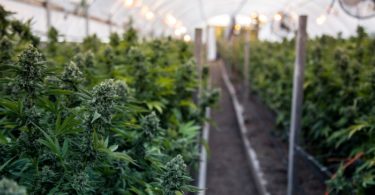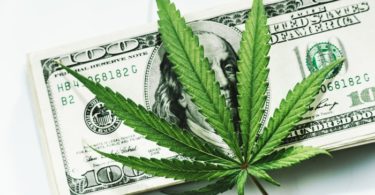In case you haven’t noticed, big money is flowing into the legal cannabis industry. Although we’re talking about an industry that didn’t even top $10 billion in global sales in 2017, investment banks Jefferies and Cowen Group project that global annual sales will soar to $50 billion and $75 billion, respectively, by 2029 and 2030.
The idea that these revenue dollars have to wind up somewhere has been the primary reason marijuana stocks have pushed higher. Arguably, no pot stock has merited more attention than Canopy Growth (NYSE:CGC), which has risen from the mid-$1 range to the mid-$42 range in the past four years, and now sports a market cap of nearly $15 billion.

IMAGE SOURCE: GETTY IMAGES.
Canopy Growth’s sales forecast will shock you
What does the future have in store for Canopy Growth? Normally, we wouldn’t be able to answer that question, given that Wall Street hasn’t been willing to offer sales or profit guidance on pot stocks of any size for more than a year into the future. But when it comes to Canopy Growth, Wall Street’s consensus looks all the way to fiscal 2022 (Canopy operates on a non-calendar fiscal year).
So, what exactly does Canopy’s sales progression look like, according to Wall Street’s consensus? Let’s take a look (figures listed in Canadian dollars, with U.S. equivalent in parenthesis):
- Fiscal 2018: CA$77.9 million ($58.5 million), actual
- Fiscal 2019: CA$246 million ($184.8 million), estimate
- Fiscal 2020: CA$832 million ($625 million), estimate
- Fiscal 2021: CA$1.4 billion ($1.05 billion), estimate
- Fiscal 2022: CA$2.8 billion ($2.1 billion), estimate
For those of you keeping score at home, that’s a compound annual sales growth rate of 144.8% between 2018 and 2022. And, more importantly, if Canopy Growth were to hit $2.1 billion in sales by 2022, it would be valued at less than seven times annual revenue, assuming a static share price over the next four years. That’s certainly better than the close to 85 times sales the company will be valued at when fiscal 2019 comes to a close, assuming Wall Street’s consensus figures are accurate.

IMAGE SOURCE: GETTY IMAGES.
Take special note of these two years: 2020 and 2022
It’s also worth noting that Wall Street’s consensus revenue forecast has two very large jumps in aggregate sales built in between 2019 and 2020, and 2021 and 2022. My suspicion is that these increases relate to two key events.
First, the massive jump from $184.8 million in estimated sales this year to $625 million in estimated sales in 2020 probably represents Canada successfully working through a number of supply chain issues. For instance, a shortage of regulatory compliant packaging has left both raw and processed cannabis waiting in the wings. Additionally, a huge backlog of cultivation applications and sales permits at Health Canada has constrained supply. Canopy, for its part, is ahead of the game in having more than 4.3 million square feet of its 5.6 million square feet of cultivation space already licensed. The huge uptick in 2020 sales looks to be related to the maturation of Canada’s recreational market.
Second, the doubling in sales from $1.4 billion in fiscal 2021 to fiscal 2022 could signal a long-awaited legalization of marijuana in the United States.
Although this is pure conjecture on my part, Wall Street is growing ever more convinced that the United States will legalize marijuana sooner rather than later. With Republicans maintaining control of the White House and Senate until at least January 2021, and the GOP historically not in favor of legalizing cannabis, it would appear that Wall Street is counting on a new Congress (and perhaps president) to push for the legalization of marijuana in 2021. There’s no doubt that the U.S. would absolutely dwarf Canada in total pot sales if legal, and Canopy Growth should have an upper hand if that ever comes to fruition thanks to the hemp-processing infrastructure it’ll be constructing in New York state.

IMAGE SOURCE: GETTY IMAGES.
The big question: When will Canopy Growth be profitable?
Of course, the biggest question mark of all is when the largest pot stock in the world will actually start delivering a profit for its shareholders. A recent look at Canopy and some of its closest peers found that while it might be the largest marijuana stock by market cap, it was liable to bring up the caboose in the profit department. Here’s what Wall Street investment firms have to say (once again, all estimates are in Canadian dollars):
- Fiscal 2018: (CA$0.40), actual
- Fiscal 2019: (CA$1.78), estimate
- Fiscal 2020: (CA$0.24), estimate
- Fiscal 2021: CA$0.46, estimate
- Fiscal 2022: CA$2.06, estimate
According to these projections, Canopy Growth is still a good two to three years away from hitting recurring profitability on a quarterly basis, which may rightly give some investors pause. This is a company that’s laser-focused on expanding into new markets, as well as planting the seed, so to speak, in the U.S. with its hemp-processing facility. Put simply, profits aren’t a top priority for the time being.
However, if the company does match Wall Street’s consensus in 2022, it’ll be valued at about 28 times its earnings per share. That seems reasonable — but it also assumes that Canopy’s share price remains static for four years, and that nothing changes with these estimates, which is highly unlikely in the cannabis space.
Clearly, Canopy Growth’s top line is heading in the right direction. But with so many production and legalization uncertainties, it’s difficult to trust that these long-term profit projections will come to fruition.






